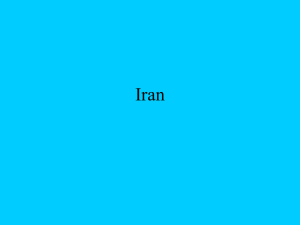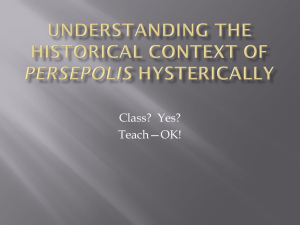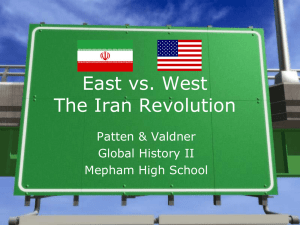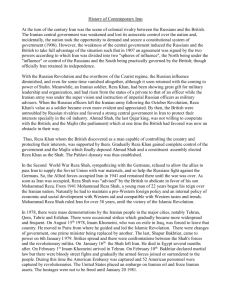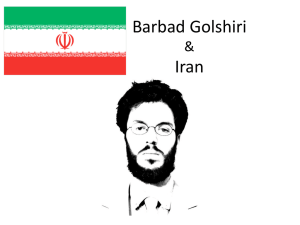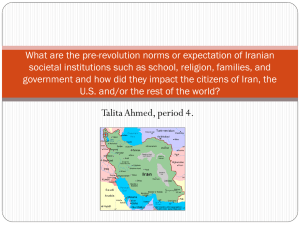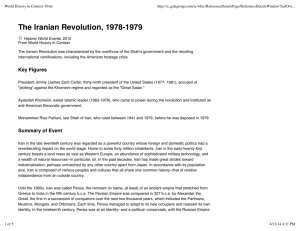A Reader`s Guide to Marjane Satrapi`s
advertisement
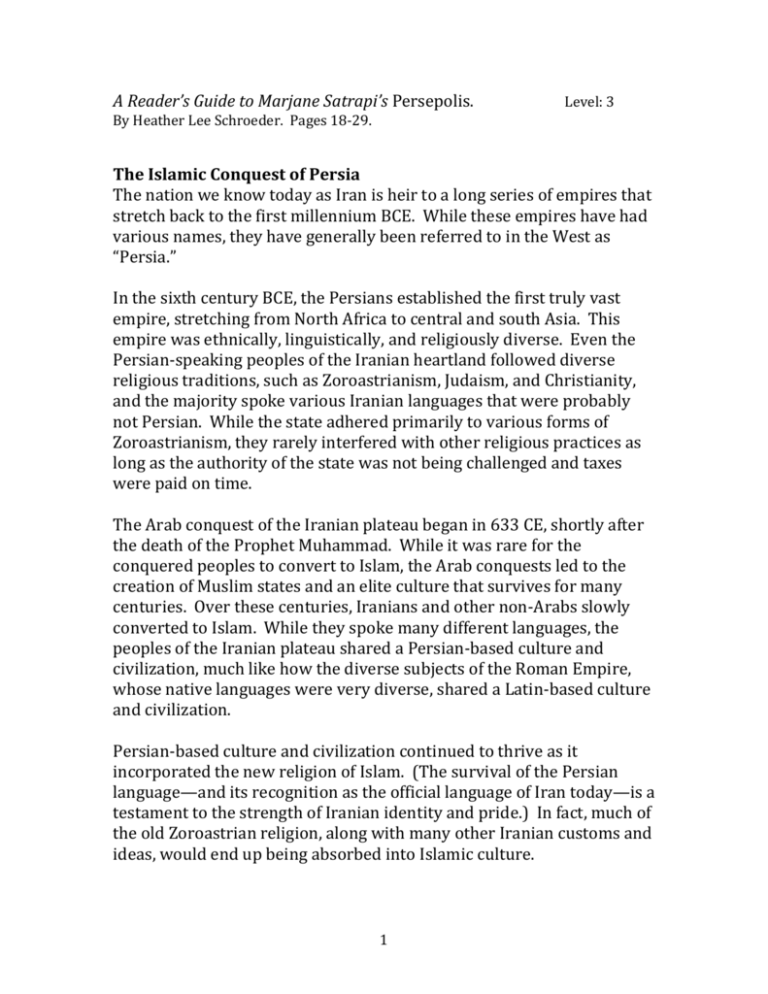
A Reader’s Guide to Marjane Satrapi’s Persepolis. Level: 3 By Heather Lee Schroeder. Pages 18-29. The Islamic Conquest of Persia The nation we know today as Iran is heir to a long series of empires that stretch back to the first millennium BCE. While these empires have had various names, they have generally been referred to in the West as “Persia.” In the sixth century BCE, the Persians established the first truly vast empire, stretching from North Africa to central and south Asia. This empire was ethnically, linguistically, and religiously diverse. Even the Persian-speaking peoples of the Iranian heartland followed diverse religious traditions, such as Zoroastrianism, Judaism, and Christianity, and the majority spoke various Iranian languages that were probably not Persian. While the state adhered primarily to various forms of Zoroastrianism, they rarely interfered with other religious practices as long as the authority of the state was not being challenged and taxes were paid on time. The Arab conquest of the Iranian plateau began in 633 CE, shortly after the death of the Prophet Muhammad. While it was rare for the conquered peoples to convert to Islam, the Arab conquests led to the creation of Muslim states and an elite culture that survives for many centuries. Over these centuries, Iranians and other non-Arabs slowly converted to Islam. While they spoke many different languages, the peoples of the Iranian plateau shared a Persian-based culture and civilization, much like how the diverse subjects of the Roman Empire, whose native languages were very diverse, shared a Latin-based culture and civilization. Persian-based culture and civilization continued to thrive as it incorporated the new religion of Islam. (The survival of the Persian language—and its recognition as the official language of Iran today—is a testament to the strength of Iranian identity and pride.) In fact, much of the old Zoroastrian religion, along with many other Iranian customs and ideas, would end up being absorbed into Islamic culture. 1 Iran was indeed Islamized, but it was not Arabized. Persians remained Persians. And after an interval of silence, Iran reemerged as a separate, different and distinctive element within Islam, eventually adding a new element even to Islam itself. Culturally, politically, and most remarkable of all even religiously, the Iranian contribution to this new Islamic civilization is of immense importance. The work of Iranians can be seen in every field of cultural endeavor, including Arabic poetry, to which poets of Iranian origin composing their poems in Arabic made a very significant contribution. In a sense, Iranian Islam is a second advent of Islam itself… It was this Persian Islam, rather than the original Arab Islam, that was brought to new areas and new peoples: to the Turks, first in Central Asia and then in the middle East in the country which came to be called Turkey, and of course to India. Indeed, the absorption of Persia into the Islamic Empire would ultimately culminate in the “Islamic Golden Age.” By the tenth or eleventh century, it is likely that a majority of Iranians were Muslim, although there were very large Zoroastrian, Christian, and Jewish communities. Most of these Muslims were Sunni Muslims. Modern Iran, however, is almost exclusively part of the Shi’i branch of the Muslim faith—becoming so with the rise of the Safavid Empire, which was established in 1501. Period of Decline In 1219, Persia suffered a devastating invasion from the hordes of Genghis Khan, which wiped out nearly half its population. More mass exterminations and famine ensued. Genghis Khan was followed by another conqueror, Tamerlane, who continued the devastation. However, this period, ironically, was also a period of great cultural achievements within the Persian-based culture of Iran. Many of the greatest Persian languages poets emerged during this period, and there were many great achievements in art and architecture as well. Recovery Shah Ismail I established the Safavid Dynasty in Persia in 1501. Over the next three hundred years or so, dynastic power would shift from the Safavid, to the Afsharid, the Sand, and finally the Qajar Dynasty, establish in 1794. The Qajar Dynasty established Iran’s first modern 2 system of higher education, which was intended to replace the traditional system of higher learning that centered on private education through a system of master and apprentice or the religious education offered at the great religious seminaries. They also pursued other reforms, with occasional success. Although was caused Persia to lose much of its land to Russia and Great Britain during Qajar rule, the empire survived and served as the basis for the modern nation of Iran. One important achievement was that Iran is relatively unique in that it was able to successfully resist foreign colonialism. The Shah of Iran The Qajar Dynasty was overthrown in 1921 in a military takeover led by a soldier named Reza Khan. Reza Khan proclaimed himself shah shortly thereafter, in 1925. In 1935 Reza Shah insisted that Western nations refer to this modern nation as Iran. While Iran is one of the indigenous terms used by Iranians to refer to the land and its people, Persia was a foreign term, based on the old term for the Iranian languages of Parsi, or Farsi. The reign of Reza Shah lasted until August 1941, when the nation’s strategic value in World War II caused the Allied Powers of Great Britain and the Soviet Union to occupy Iran. Reza Shah would be forced to abdicate in favor of his son Mohammad Reza Pahlavi. Modern Iran The new shah would rule Iran for nearly forty years. Under his leadership, many reforms and initiatives were launched with the hopes of modernizing Iran and turning the nation into a world economic and military power. While he had several notable successes and failures, his reign ended in a crisis of legitimacy, and a popular revolution led to his overthrow. Many of these initiatives failed due to political opposition to his policies inside Iran, cold war politics, and deeper internal and external obstacles to economic growth. It did not take long for opposition to develop to the shah’s policies. In 1951 Dr. Mohammed Mossadegh was elected prime minister of Iran, with strong support from liberal modernists and leftists in Iran. He 3 became wildly popular with the Iranian people by leading the effort to nationalize Iran’s oil reserves, which were controlled by the British at the time. This created friction, naturally, with Great Britain, and with the United States as well, which also had economic stakes in Iranian oil. In 1952, United States president Dwight D. Eisenhower authorized a C.I.A. operation designed to remove Mossadegh from power. This culminated in Mossadegh’s arrest in August of that year. This incident would increase resentment toward the shah and also increased antiAmerican sentiment in Iran. Ever since that coup, Iranians have been angry at the United States for using a coup to end democracy in Iran and put a dictatorial king in its place. The shah faced opposition from many fronts. One important group was the conservative religious establishment, or the clergy. The most prominent clergyman who criticized the shah leader was Ayatollah Ruhollah Khomeini. In 1963, Khomeini denounced the shah in a serious of public speeches. He was arrested, which sparked riots. For the next year and a half, the shah’s struggles with Khomeini continued, until finally he forced Khomeini into exile in November 1964. Khomeini lived briefly in Turkey (less than a year) before relocated to Najaf, Iraq. He would stay there until 1978, when he moved to France, where he participated in anti-shah political activity. Ultimately a revolution unfolded in 1978-1979, and the shah was overthrown. It is at this point that Persepolis begins. 4

